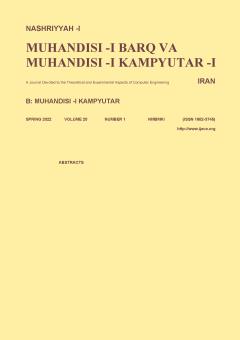یک سیستم بینایی هوشمند برای نظارت خودکار بر آتشسوزی جنگلها
الموضوعات : electrical and computer engineeringمحمدصادق کیهانپناه 1 , بهروز کوهستانی 2
1 - دانشگاه تبریز،دانشکده مهندسی مکانیک
2 - دانشگاه تبریز،دانشکده مهندسی برق و کامپیوتر
الکلمات المفتاحية: آتشسوزی جنگل, پردازش تصویر, شبکه عصبی کانولوشنی, یادگیری عمیق,
ملخص المقالة :
مقابله با آتشسوزی جنگلها برای جلوگیری از خطرات بالقوه آنها و همچنین حفاظت از منابع طبیعی به عنوان یک چالش در میان محققان مطرح است. هدف از این تحقیق، تشخیص ویژگیهای آتش و دود از تصاویر بصری پهپاد برای دستهبندی، تشخیص شیء و قطعهبندی تصاویر است. از آنجا که جنگلها محیطهای بسیار پیچیده و غیر ساختاری هستند، استفاده از سیستم بینایی همچنان با مشکلاتی نظیر شباهت ویژگیهای شعله با نور خورشید، گیاهان و حیوانات و یا پوشش شعله با دود مواجه است که باعث هشدارهای اشتباه میشوند. روش پیشنهادی در این تحقیق، استفاده از شبکههای عصبی کانولوشنی از روشهای یادگیری عمیق است که به صورت خودکار، توانایی استخراج یا تولید ویژگی در لایههای مختلف خود را دارند. ابتدا به جمعآوری داده و افزایش آنها با توجه به روشهای دادهافزایی پرداخته شده و در ادامه، استفاده از یک شبکه ۱۲ لایه برای دستهبندی و همچنین روش یادگیری انتقالی برای قطعهبندی تصاویر پیشنهاد میشود. نتایج به دست آمده نشان میدهند که روش دادهافزایی به کار برده شده با توجه به تغییر اندازه و آمادهسازی تصاویر ورودی به شبکه از کاهش شدید ویژگیهای موجود در تصاویر اولیه جلوگیری کرده و همچنین شبکههای عصبی کانولوشنی مورد استفاده میتوانند به خوبی ویژگیهای آتش و دود موجود در تصاویر را استخراج کنند و نهایتاً به تشخیص و محلیسازی آنها بپردازند.
[1] C. Yuan, Y. M. Zhang, and Z. X. Liu, "A survey on technologies for automatic forest fire monitoring, detection, and fighting using unmanned aerial vehicles and remote sensing techniques," Canadian J. of Forest Research, vol. 45, no. 7, pp. 783-792, Jul. 2015.
[2] J. R. Martinez-de Dios, et al., "Computer vision techniques for forest fire perception," Image Vision Comput, vol. 26, no. 4, pp. 550-562, Apr. 2008.
[3] K. G. Hirsch and P. Fuglem, Canadian Wildland Fire Strategy: Background Syntheses, Analyses, and Perspectives, Canadian Council for Forest Ministries, Natural Resources Canada, Canadian Forest Service, Northern Forestry Centre, Edmonton, Alberta, 2006.
[4] H. Lin, Z. Liu, T. Zhao, and Y. Zhang, "Early warning system of forest fire detection based on video technology," in Proc. of the 9th Int. Symp. on Linear Drives for Industry Applications, vol. 3, pp. 751-758, Hangzhou, China, 7-10 Jul. 2013.
[5] E. Den Breejen, et al., "Autonomous forest fire detection," in Proc. of the 3rd Int. Conf. on Forest Fire Research, pp. 2003-2012, Luso, Portugal, 16-20 Nov. 1998.
[6] R. W. Beard, T. W. McLain, D. B. Nelson, D. Kingston, and D. Johanson, "Decentralized cooperative aerial surveillance using fixed-wing miniature UAVs," Proceedings of the IEEE, vol. 94, no. 7, pp. 1306-1324, Jul. 2006.
[7] H. Olsson, et al., "Current and emerging operational uses of remote sensing in Swedish forestry," in Proc. of the 5th Annual Forest Inventory and Analysis Symp. USDA Forest Service, pp. 39-46, Portland, ONn, USA, 3-6 Oct. 2005.
[8] J. A. J. Berni, P. J. Zarco-Tejada, L. Surez, and E. Fereres, "Thermal and narrowband multispectral remote sensing for vegetation monitoring from an unmanned aerial vehicle," IEEE Trans. Geosci. Remote Sens., vol. 47, no. 3, pp. 722-738, Mar. 2009.
[9] J. Everaerts, "The use of unmanned aerial vehicles (UAVs) for remote sensing and mapping," Proc. Int. Archives of the Photogrammetry, Remote Sensing and Spatial Information Sciences, vol. 37, Pt. B1, pp. 1187-1192, Beijing, China, 3-11 Jul. 2008.
[10] V. G. Ambrosia and T. Zajkowski, "Selection of appropriate class UAS/sensors to support fire monitoring: experiences in the United States," in Handbook of Unmanned Aerial Vehicles, Edited by K. P. Valavanis and G. J. Vachtsevano, Springer, Netherlands, pp. 2723-2754, 2015.
[11] R. Sporea, Color Space and Color Model, (http://www.opticallimits.com)
[12] M. Pietikainen, A. Hadid, G. Zhao, and T. Ahonen, "Local binary pattern for still images," In: Computer Vision Using Local Binary Patterns. Computational Imaging and Vision, vol 40, pp. 13-47, London: Springer, 2011.
[13] T. X. Truong and J. M. Kim, "Fire flame detection in video sequences using multi-stage pattern recognition techniques," Engineering Applications of Artificial Injelligence J., vol. 25, no. 7, pp. 1365-1372, Oct. 2012.
[14] G. W. Lindsay, "Convolutional neural networks as a model of the visual system: past, present, and future," J. of Cognitive Neuroscience, vol. 33, no. 10, pp. 1-15, Sept. 2020.
[15] S. Frizzi, et al., "Convolutional neural network for video fire and smoke detection," in Proc. IECON 42nd Annual Conf. of the IEEE Industrial Electronics Society, pp. 877-882, Florence, Italy, 23-26 Oct. 2016.
[16] Y. Zhao, J. Ma, X. Li, and J. Zhang, "Saliency detection and deep learning-based wildfire identification in UAV imagery," Sensors, vol. 18, no. 3, Article ID: 712, Feb. 2018.
[17] H. Pan, D. Badawi, and A. E. Cetin, "Computationally efficient wildfire detection method using a deep convolutional network pruned via Fourier analysis," Sensors, vol. 20, no. 10, Article ID: 2891, May 2020.
[18] https://github.com/tensorflow/models/tree/master/research/object_detection
[19] K. He, G. Gkioxari, P. Dollar, and R. Girshick, Mask R-CNN, In ICCV, 2017.
[20] T. Fawcet, "An introduction to ROC analysis," Pattern Recognition Letters, vol. 27, no. 8, pp. 861-874, Jun. 2006.
[21] D. M. W. Powers, "Evaluation: from precision, recall and F-measure to ROC, informedness, markedness & correlation," J. of Machine Learning Technologies, vol. 2, no. 1, pp. 37-63, 2011.
[22] K. M. Ting, C. Sammut, and G. I. Webb, Encyclopedia of Machine Learning, Boston: Springer, 2011.
[23] A. Krizhevsky, I. Sutskever, and G. E. Hinton, "ImageNet classification with deep convolutional neural networks," in Proc. of the 25th Int. Conf. on Neural Information Processing Systems, pp. 1097-1105, Lake Tahoe, NA, USA, 3-6 Dec. 2012.


